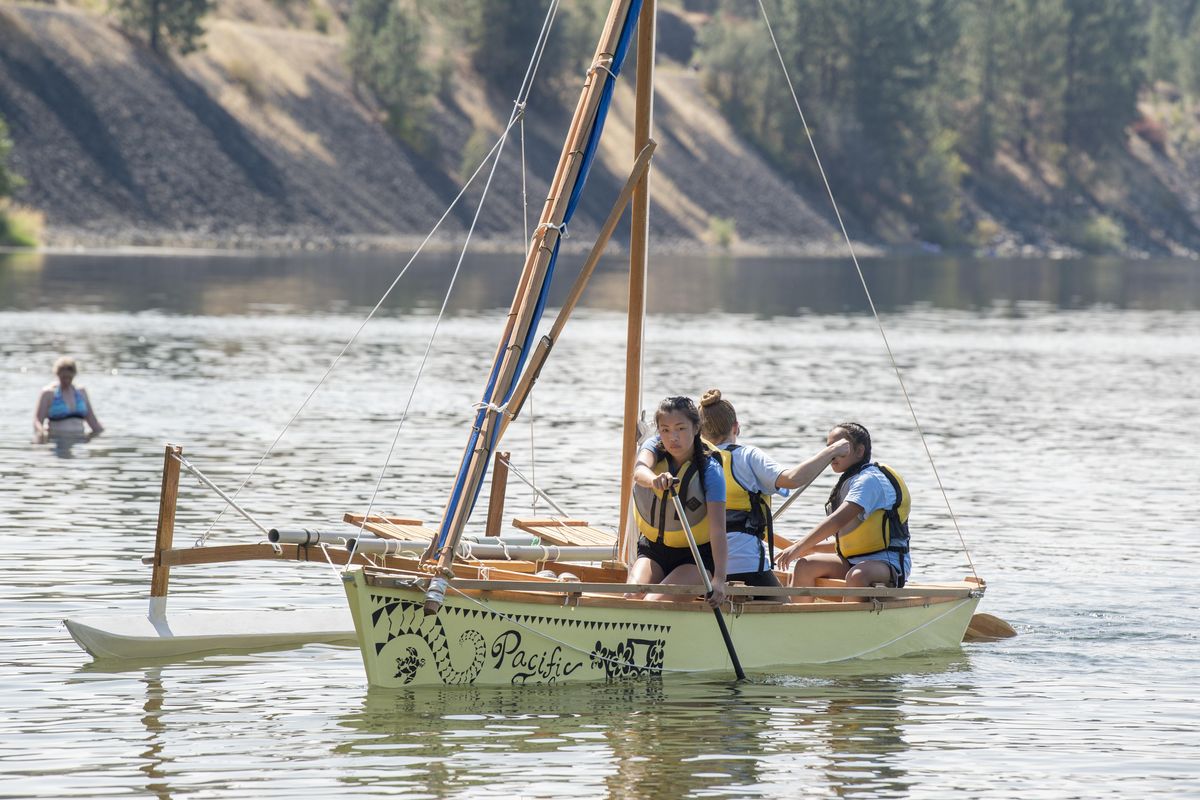Marshallese students build traditional sailing boat in summer class

Les Kaios had never sailed, much less built a sailing boat.
Still, the ocean, and boat building is in his blood. His grandfather built boats on the Marshall Islands before immigrating to the United States.
So, when Kaios, 13, built a traditional Marshallese sailing boat this summer it connected him with his heritage and helped improve his spoken and written English.
“It was fun,” he said of the project. But, more importantly it allowed him to be more “like my grandpa.”
On Tuesday, Kaios, alongside 10 of his Shaw Middle School classmates, launched the traditional Marshallese outrigger they built by hand into the calm waters of Fish Lake.
In addition to being a fun, interesting summer-school project, the boat building exercise addresses a serious and persistent problem.
The four-year graduation rate for Native Hawaiian/Other Pacific Islander, of which Marshallese students are a subgroup, was 51.4 percent in 2016. That is the lowest four-year graduation rate reported of any population group in Spokane Public Schools.
Overall the district’s graduation rate was 85.4 percent. Of the 1,800 English-language learners enrolled in the district, about 25 percent of them are Marshallese.
Much of the problem, advocates and Marshallese community members say, is students don’t feel connect to, or don’t understand, American school culture.
Marcy Ray, a first-year teacher, said the majority of the 15 students enrolled in Shaw Middle School’s English Language Learning program were from the Marshall Islands or other Pacific Island countries.
“We wanted to do something different for our English Language Development students this summer and we wanted to do something that was culturally relevant,” she said.
Doresty Daniel, a bilingual Marshallese specialist in the Spokane district spoke to the class once over the summer and told them about the culture and history of the boats.
“I talked to them about how the culture and the ocean relates to life in the Marshall islands,” Daniel said. “The land is really small. We use the ocean as a playground.”
The project helps the students feel welcomed and connected into a new culture, said Daniel who is originally from the Marshall Islands.
“It’s a great project for the kids from … from the Marshallese community, to know that the school cares about their culture,” she said.
Scott Franz, an after-school volunteer at Shaw Middle School, was the master boat builder.
Franz, an avid sailor, makes nautical maps for a living. When he heard the class wanted to build a traditional Marshallese sailboat, he was intrigued.
So, he started researching how to build the ancient vessels.
Then he volunteered at the school for two hours a day for three weeks. He would go to the school in the mornings and help the students. Then he’d go home to his “day job” printing nautical maps.
In the evening he would stain and seal the wood so it would be ready for school the following morning.
“It was the busiest summer I ever had,” he said.
The project seemed to work, Ray said. The students were engaged and interested. Students who were late every day of the school year showed up half-an-hour early, Ray said.
“We wanted to do it in a way that was real and that they would connect to,” she said.
“For most of them they may have family members who were boat builders,” she added.
That was the case for Mary Jingle Arcnas.
Arcnas, 15, is Filipino, but boat building, and the ocean, are an integral part of traditional Filipino culture. The summer project helped Arcnas connect with that part of her heritage. And it helped improve her English.
“I was kind of struggling with reading the instructions,” she said.
The project kept her interest and her reading and speaking improved.
Jon Swett, the principal of Shaw Middle School, has never seen project like this.
“What’s really amazing is the level of engagement these kids had about learning math and literacy,” he said. “If they can connect their learning to culturally relevant (issues) the learning is faster and deeper.”